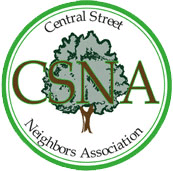Trains, Condos, and Automobiles
My mini-tour of some of the local condo offerings led to some larger mullings. Altogether, the 4 developments I covered, representing nearly 100 new condos within a 9-iron shot of the Central Street Metra station, raise interesting questions. No doubt all will eventually sell; but at what price? One wonders if the demand for "transit-oriented" luxury condos here hasn’t been overestimated.
Just as gardening means more than dumping a bunch of dirt and seed in a yard, transit-oriented development means more than plunking a condo next to a train station. 
Transit at the Central and Green Bay "hub" consists of (a) heavy commuter rail and (b) buses. Studies indicate a big difference in who uses commuter rail (as opposed to light rail like the "L"). Typically, commuter rail riders are single-family homeowners, in families with children, for whom the higher cost and lower-frequency, but predictable schedule of heavy rail are not deterrents. Condo and apartment dwellers, by contrast, tend to be urbanites who ride light rail, and vice versa. Suburbs of all types have had trouble getting residents to ride buses. Central Street is already lined with hundreds of condo units, yet the buses run fairly empty.
By any measure, Evanston is already well-developed, with both a high population density and a high housing density, and by any measure, already transit-oriented, nearly tops among all Illinois communities in transit use. Very little hard data anywhere suggests transit use is increased in an already established, relatively affluent suburb by denser, luxury condo development. Residents in denser places do use more transit -- but the hard data indicates that that's because urban density consists disproportionately of people who can't afford cars, or whose cars are undependable, or who can't drive. Transferring that statistical correlation to a market for whom having at least one car is a given is as speculative as some developments.
The dramatic increase in gas prices will impact transit ridership among those for whom transit's already an option. However, a 12,000-mile/yr. suburban commuter who gets 22 mpg is taking "only" an $1100/yr. hit when gas goes up by even $2/gallon. $1100 in increased annual automobile costs is not enough to make the owner of a $600,000 home in Hoffman Estates sell their house, incurring $30,000-$40,000 in broker's fees, title charges, attorney's fees, and moving costs, for the privilege of being in a much smaller home next to a train line in Evanston. Especially not if her or his job is in Schaumburg.
The target markets, for many if not most of the new Evanston units, seem to be (a) empty-nesters from Evanston or nearby, or (b) thirty-somethings, perhaps selling a condo in Lincoln Park or Lakeview, who seek a less congested, potentially more child-friendly environment, possibly closer to a job in the north suburbs, possibly while they save up money for a single-family detached home (which remains the housing format of choice for the young American family). The ex-Lincoln Parkers probably still want to drive, and may be moving here to be closer to their auto-commute job further north, and the empty-nesters are not considering commuting as the biggest factor in their buying decision. Therefore it's debatable how "transit-oriented" development is at this price range.
Also, both markets need to sell their existing home. That factor is rippling through the entire move-up market.
The Eastwood, the most overt in its marketing about being near trains, shows the Northwestern shuttle bus and both rail lines in its impressive brochure. I'm not sure why they don't show the regular CTA and PACE buses. One challenge for marketing condos in the Central Street neighborhood is that the quaint, eclectic "village" feel doesn't have, and isn't supposed to have, the bustle of downtown Evanston. This is an attraction for many, but perhaps not for the luxury condo set.
Central Street could perhaps use one or two more places to have a glass of wine, or hear a little jazz, to have the cachet of a neighborhood that will attract those for whom the interiors and location of these developments are a hot commodity. In the meantime, why doesn't anyone tell potential buyers how easy it is to get to downtown Evanston from here? Two different bus lines come through the Central/Green-Bay hub, in addition to the Metra. If you get tired of Bluestone every night (is that possible?), it's like having your own private chauffeur to Prairie Moon or Bill's Blues.
Evanston and its residents are being sold on development because it is supposedly "transit oriented." I'll believe that's so when I see as much emphasis on mass transit and an auto-free lifestyle in all the marketing materials as what I see about stainless steel refrigerators.
- jeffpsmith's blog
- Log in to post comments
